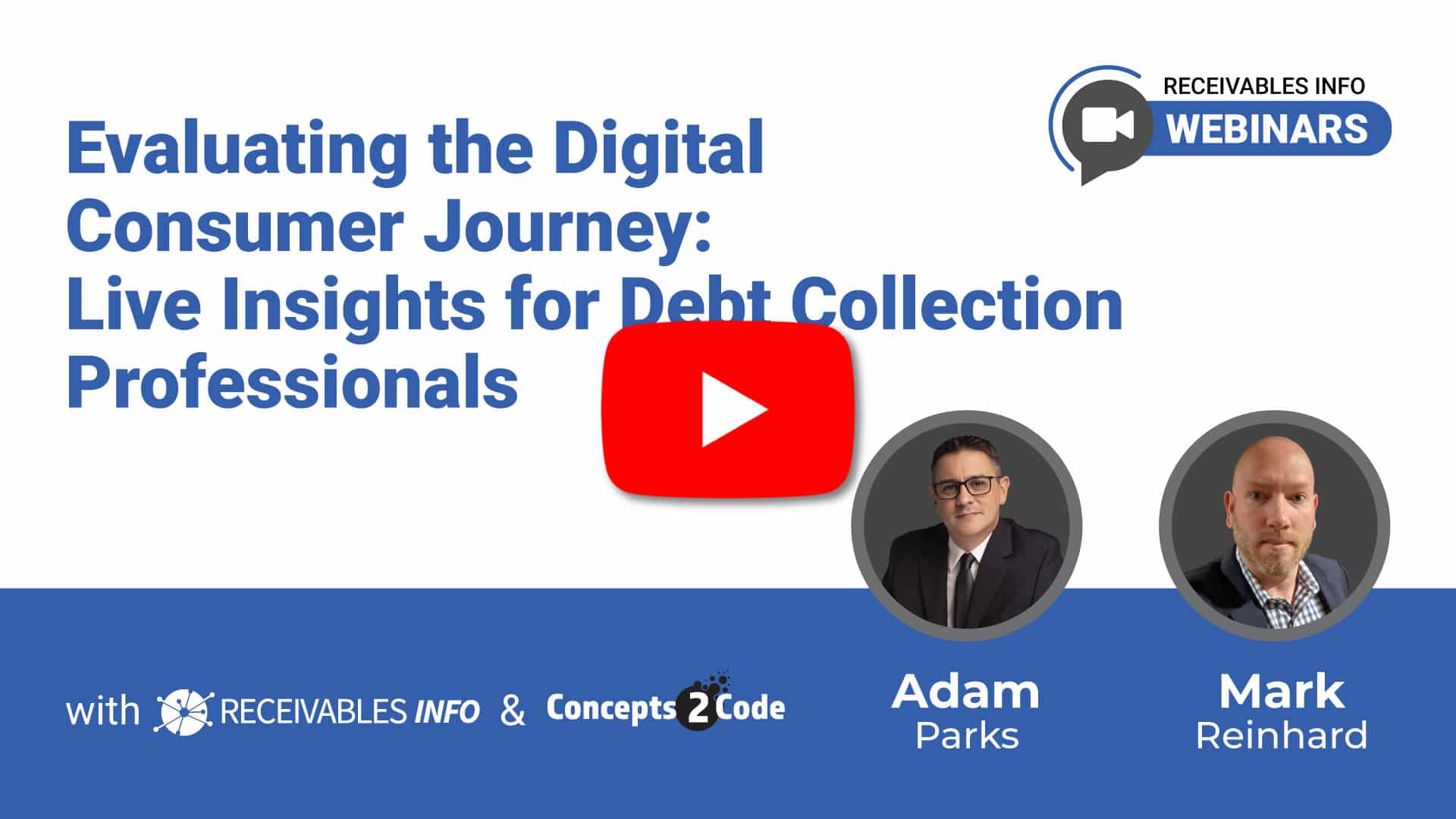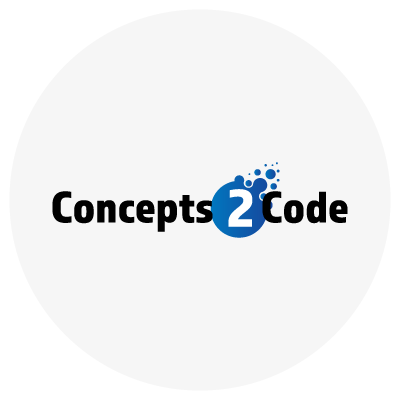Are your consumer journeys driving results or blocking payments? Learn from Mark Reinhard (Concepts2Code) as he breaks down authentication friction, self-service strategy, and API integrations to empower debt collection performance. Build portals that convert.
Adam Parks 0:20
Yep, I Oh, so Mr. Reinhard,
Mark Reinhard 1:50
yeah, he joined it. Yes,
Adam Parks 1:52
yeah, he's just joining.
Mark Reinhard 1:58
Hello. Hello.
Adam Parks 2:02
You don't like you're in your usable spot. I'm at home. I do have a home.
Mark Reinhard 2:10
Hello, I see microphones using Can you hear me? Okay, yeah, oh yeah. You sound a little distant,
Adam Parks 2:16
but it's I can
Mark Reinhard 2:19
hear you. SP, I see that better or worse? Better. Okay,
Adam Parks 2:28
way better. Weird.
Mark Reinhard 2:33
The one that I think it's over here, you would think the one over there would sound better. I don't know,
Adam Parks 2:39
like, I can't explain microphones to you.
Mark Reinhard 2:42
And I wish there was a, like, a better way to know, like, because you're talking here like, I don't know if this sounds better. If I should move my own microphone. It's like, you need to go. And if people don't tell you you're like, you're totally unaware. Well, so I use
Adam Parks 2:54
a like when I'm recording now I use Mont like, like monitors, so I have like, a set of road like on stage, type of musician monitors that I use so that I can hear myself, I could hear them, but this is what the final recording sound like. Makes a lot easier for me, and I don't have to wear the big over the ear headphones that make me look like Princess Leia.
Mark Reinhard 3:18
I always feel like I look so weird in those because without hair, you have like, this gap of it where it's space, it just, it just looks like I have, like a ring on my head. When you have hair, it kind of blends in, or whatever. Let's see what. Yeah, it never
Adam Parks 3:32
looks right for me. Alright, so for today, here's what I had lined up. We're going to do this as a LinkedIn live webinar, because LinkedIn live has been kicking ass and taking names, plus it gives me an hour of content to work from. So like I did one the other day with why refi on student loans, and I've got, I think, 12 or 15 short videos coming out of that. So good, yeah, and the short videos are really what we're kicking ass right now, both on YouTube and on LinkedIn, it's working out really well. So I want to talk a little bit about the current topic that I have planned for this. We're not going to do it as a deck, but you can do screen share or whatever, if you want to, as we talk about this. But the topic I had was evaluating the digital consumer journey at 360 analysis for deck collection companies. So my thought process here was, like, how deep into the analytics can we go in talking about the storyline for individual consumers? Like, do we want to go down the path of talking about so you have some consumers that come in via a text message and then they have to authenticate? I'll tell you what really drove this home for me the other day as I was consulting for a client, like a website client that called me, and I want to say they're using like a repay portal or something, and they were like, you know, we're just, we're getting like, 8% payments on all of our outbound stuff. And I was like, Oh, well, it's like, walk through the process together. Let's see what it's like to be a consumer. And so I clicked on the link, and it brought me to a login page where I had to have some information that nobody would ever have. It was, like, the collection agencies account number and something else that, like, was not something that the person would know. And I was like, Well, I don't understand, why is this your authentication? Because, you know, because we got to make sure we got the right person. And I'm like, oh, there's a lot of ways that you can do that. Like, I don't understand, yeah, and where sometimes
Mark Reinhard 5:20
that it's the compliance people scare us away from using things that make sense. You got to look at it. It's like, what are you doing? You're preventing someone from paying your bill. Like, is this been a one time? Is this a real problem, even a
Adam Parks 5:38
one time payment? And that's what really got me, because it's one thing to say, like, okay, they can't authenticate and log in, fine. If that's your compliance take on the requirements. It's not my compliance take on the requirements. Well, pretend that it is yours. Fine. Like I can, I can live with that, but there's limitations to that. No, like, a one time payment, like, I can't even just go in and pay the bill one time with some sort of an identifying number. Less for the social on a date of birth should be more than enough to accurately identify a consumer, and that consumer would know both of those things at the same time. Am I missing something? We
Mark Reinhard 6:14
have a setting in there too called like, allow like unconfirmed payments. So if it's like you say, you use last name and zip code, which I'm not saying that's good or bad, but there could be two Smiths that, oh, in the same zip code and whatever. And it basically says, Do you allow a payment if that person, if you can't figure out that they're all they're matching to more than one and and they can go on the conservative side, say, No, oh, we can't find your account. Please log in, and then they got to go create they got to go through the full registration process. But if they can, if they want to set that to true, it's up to the agency. It says they'll allow the payment. It shoots them an email, said, We just took a payment. You need to review this further to make sure it's applied to the right account. And in that and at that point in time, we're only looking really at the first name, or, sorry, the last name, but they can manually review, oh, the first name on the credit card was this. We get other information later down the line. Or this guy has a $10 balance. He just paid $500 I'm pretty sure it's the bigger balance, like it allows a manual and, worst case scenario, they can refund it and say we couldn't figure out who you were, or whatever they can call the person, but, like,
Adam Parks 7:26
you should, but it provides options. Yes, yeah, it provides options, and it allows you to engage with the consumer, but that's what I'm that's what I'm talking about here. And then we people are talking to me about email addresses, right? So, like, they're, they're sending out these emails. And now, what is the What's it actually look like flowing through? Like, what's that flow through start to look like they authenticate. And now, am I doing these abandoned cart messages? How deeply am I tracking these consumer journeys? And how are we building them? Yeah, that's a question for you, like, how are we building these consumer journeys? Like, What? What? What options are there from an analytical standpoint? Because I've continually challenged like my clients and give me these questions, I say, All right, well, go to your payment portal provider and ask them to install at least Google Analytics so that we can start trying to build some customer journeys. And 90% of them will say no.
Mark Reinhard 8:22
They'll say no. Why would they say no? That's a great question, compliance, that's probably the reason. But no, I don't talk
Adam Parks 8:29
about the client. I'm talking about the portal. The portal saying no, and I'm going, I don't like repaying like No, all right, well then what are you one, what are you trying to hide? And two, even on the ones that I have been able to get it done with the the readouts from the events and things, is like a whole other ball game. Yeah, so I'd be interested. I mean, we don't tie directly
Mark Reinhard 8:50
into Google Analytics, but we do track all these things, like a decline payment someone, someone went in and their car got declined for 100 bucks. Well, you know what? Maybe take, maybe you should reach out to them. Hey, we see you trying to pay. Please call us for other payment arrangement options, whatever, just so very vague, or
Adam Parks 9:08
too, you could say they
Mark Reinhard 9:09
got $100 balance, offer them a $50 settlement and see if they pay that, whatever it is. But so we give them the declines and also the failed attempts, like this person's attempting to do something and they're failing for whatever reason. Usually it's a client card, but sometimes it's silly stuff, like they literally can't figure out what, which account they want to pay on, or whatever. They made it here and they but they didn't make payment. So basically, either they logged in or they did something, so we know who they are, but they didn't make a payment, then they could literally be and you gotta, you gotta understand what you're looking for, as far as that goes, too, because you have to look at things in context. A person may log in and not pay a bill, and your immediate instinct is, we should that person didn't pay a bill, but no, some people set up a payment arrangement and they log in periodically to see what their next payment is. So they logged in, they didn't make a payment, but they're on a payment arrangement. So that's a reasonable activity. But what did you just learn? You learn that person's checking in on their payments. That's good information. One, that's an engaged debtor. Two, maybe, maybe they had worried about the payments coming in that are different. You know, they're not gonna have enough money, whatever it is, but it's someone who you can likely reach out to if there's a problem, versus an unengaged debt or sets up a payment plan you never hear from them again. Yes, it
Adam Parks 10:25
actually when you're saying that, and you're now, you're kind of talking a little bit about the personas related to the consumers that are currently in debt. I don't know if you've seen this article yet, but this might be an interesting tie in for us. Basically wrote this article called The eight personas of consumers and deck collection. I'm about to update this to the 10 personas, because, based on the conversation that we had, right, like, with the people that were reading it, it's all industry folks, right? But, like, based on the feedback that I got here, we're going to apply two more of them to the process here, but maybe this would be interesting, because it talks about the different types of consumers, and then what kind of strategy ultimately works with that type of consumer. So like, you have that person who's, you know, you're saying, like an in date engaged consumer, and how does that start to fall into this? So maybe this is something you might want to take a look at in advance of the session. And we could probably interweave some of these ideas, because you have some people that are never going to go like combative Chris is never going to go to like, you're not even going to go to the portal like he doesn't believe that he owes this debt, or that anybody, that anyone should ever have to pay their debt. I mean, maybe he's talker and you know, he just believes that nobody should ever have to pay their debt. You know, defensive. Dave might actually go check it out. He's defensive and feels like everything is a personal attack. But he might actually go into a portal and engage. And I think, from a self service perspective, this is what the future starts to look like. You know, I know when you talk about portals and we talk about self service, you know, we've always talked about payments, but talk to me about some of the other things that need to be available to be part of that online consumer journey. What are the other features, functions, pieces and parts that should be part of self service, beyond the payment so I think just having access to view your
Mark Reinhard 12:21
information so that comes after some sort of authentication. People, especially people, you know, student loans, medical where you've got 10 or more, you know, 510, whatever accounts you have, multiple invoices on your account. You really want to understand why what you owe you should be able to see a breakdown of your of your balance, and nothing worse than getting a bill $8,000 What the hell is this like? Oh yeah, I was at that doctor that oh yeah, I forgot about that doctor. You know, there's something to having information that makes you a little bit okay, at least I know what it is. Or maybe, maybe I'm pissed because that hospital screwed me one day and I didn't like something that happened there. And I'm like, I'm not paying that bill, but I paying that bill, but I got nine other bills, and I'm okay with paying one, because those are unrelated. Well, even though pick those nine and pay those and, you know, but, but if they just send you one bill and it's all you see is the total balance that you owe it, you feel like you don't have control. And then, okay, control be like a primary factor
Adam Parks 13:20
here. It's about empowering that consumer to feel like they've got control over what is happening here. They may owe that debt, right? Or they may owe a lot of debts. We were on a pod or the webinar on student loans the other day, and they talked about how, like, yeah, when you took out that loan, it was $78 but if you don't start repaying it for seven or eight years, it's now $110 and then if you consider that, you took out a new loan every year, you stack those on top of each other, now you've got a $480 a month payment. Yeah, you thought you're paying $78 and that disconnect, I think, is empowering the consumer with information, sounds like a primary objective, yeah. And I would some some things
Mark Reinhard 14:02
also that you want a consumer to have access to as well, is more as a business strategy, maybe not individually, individually looking at it may seem counterintuitive, like you may allow that, like allowing someone to unsubscribe from an email or opt out of something. It sounds like I wouldn't want that because I want to be able to contact them. But really, you're working business, and you're getting a percentage of of the most collectible debt. If people are self opting out. Let you want that to be the case. You know, when someone tells you don't call them, don't call them, it's like, it's not worth pursuing, that you're in the business of we have a lot of business, and we want to focus on the most collectible part of it. So we have things. We have things on our portal, like, for an example, like bankruptcy forms and things like that. If someone just calls up and says, I'm bankruptcy, leave me alone. Blah, blah, blah, I'm not paying anything that takes up a collector's time. So we have, if someone's actually in bankruptcy, they need to file specific information. You want to give them the opportunity to supply that information, and it goes twofold. One, if it's not true, they won't be able to fill out the information when you're giving them a chance. And if it is true, you're not going to collect that debt anyway. So don't bother an agent taking all that information. I understand your situation. I'm sorry to hear that you're having financial issues. We do have a way for you for to move past this. We need you to log in, fill out this form, and after that, we're going to stop reaching out to you, and it'll go to the proper channels, back to the client, whatever it is. But think about what you just did. Your agents don't want to be on those calls. They don't want to be on calls where people, they know people aren't going to pay, but no commission there. You have to or you're represented by an attorney. You know, if you're represented by an attorney, you're really not supposed to be reaching out to them, so let them, let them provide that information, and now you have a database full of the information instead of wasting collectors time on it. So self service is for the people who truly can't pay you give them an opportunity to submit information to you. You're collecting data from them. So beyond bankruptcy, what other
Adam Parks 16:08
pieces would you consider need to be available?
Mark Reinhard 16:12
Change of Address. Oh, yeah, I got a new address, change of phone number, change of email. All of the things here are the ways this isn't this isn't my email anymore, but here's my new one or preferred method of communication. Hey, don't take don't email me. I got 27 email addresses. I prefer texting, preferred email communication. Let people tell you, and you know how it is too, like, I get 8 billion emails. Absolutely needs me. I'm like, if I'm not responding to email. You got to text me, because it's not that I'm ignoring you as I get too many emails. It's just the way it is that's me. Different people have different scenarios, but everybody live person here to help me
Adam Parks 16:51
manage my email. It's gotten to that point mark, like I can't physically manage it anymore, even with Leah, like we're just overwhelmed. So it looks like joined our team as an executive assistant to help me, like, actually be able to clear these things out.
Mark Reinhard 17:04
It's a huge challenge, because I miss things. Sometimes it's because they emailed me and they didn't copy someone else who's bore up on their email. Like, I'll catch up on my emails. Over the weekend, someone emailed me Monday, yeah, I didn't see this. I'm sorry. You know, can you meet later today? Seven days later I read it, it's just, I don't want that to be the case. That is the case, but other people have different scenarios. You know, I work all day. I'm not allowed to be on my phone, you know. So I just can't take a phone call. But if you email me, I always check my email when I get home 10 o'clock at night, whatever. Or I work day shifts and I whatever, and we take scheduled meetings.
Adam Parks 17:39
Yeah, I can't take a phone call at random. I can only take a scheduled meeting
Mark Reinhard 17:43
that I do the same thing, but, but consumers are probably have different challenges, but it's the same thing. You're letting people know what's the best way to meet with you. If you want to meet with me, schedule a meeting. You know a consumer say, if you I can only available after 10pm Well, our office is closed now, but we're going to send you an email to the portal, and you can self serve, and you can reach out to us, and we'll respond in the morning, let them know. And that's one we don't even have, but it sort of just talked, talked to myself into it is best time to reach someone. That's a great idea, not just how to reach them, best time to reach them when? Yeah, yeah.
Adam Parks 18:18
I mean, look, we're spending a lot of money on data analytics to try and figure out when's the best time to reach somebody and on which channel, I think asking them seems to be like, a pretty reasonable methodology for empowering that. Yeah, yeah. And I think, too,
Mark Reinhard 18:32
there's a lot of lot of things like that can be combined with the call and portal. You know when, when the consumers online? You get them on the line, hey, it's two seconds. I'm running out the door. I don't have time to talk. Okay, what's a good time to talk while they're on the phone? I'm going to shoot you an email right now and with all our contact information, and I'm going to just a reminder, Hey, Steve, we just talked. Thanks for your time. I know you're busy. You said four o'clock was a better time. I'm going to reach out to you at four at this number. Boom, you just solidified that, and you reminded that person who had that two second call with you, but unlikely forgot it two minutes later. So, I mean, there's, there's ways to tie these methods of communication together. Talking to a consumer on the phone should always have a follow up. Always, always, always email them, text them afterwards. Remind them of the conversation where you got, where you didn't get, whatever it is. Remind them they can access your portal. 24/7 I think that's a that's a missed opportunity. They're like, this is being worked by a collector. They're calling this person. We're not going to email them. No, you just had a call. Thanks. Email that person and say thanks for the call. Here's all the other ways you can reach us. 24/7
Adam Parks 19:39
I like that. And again, it's there. You're empowering them with the data set, and you're empowering them to provide you with the information that you ultimately need. But like getting them to do that, I think, is, you know, is the key. So when we talk about this, we've talked about mobile before. What were you gonna say? Oh, I
Mark Reinhard 19:57
was gonna say, you often go back to marketing all the time, like, why is our industry so behind? Well, is because of compliance. But every website you go to, when you leave within 30 minutes, maybe an hour, you get an email. Oh, did you forget to check out? Oh, I see, I see you liked this bag. Mark, and your birthday is coming up. Mark, treat yourself. Yeah. I mean, that becomes the
Adam Parks 20:19
hard part for us is being able to track any kind of a cookie. Like, I like, we just built a website for a law firm that they're currently reviewing, and they just messaged me this morning to tell me that, or last night to be like, Yeah, we see cookies on the site. And I'm like, No, the only cookie on there is reCAPTCHA and Google Analytics. Like, that's all that we use. No, can't have that, all right. Well, you're gonna have no analytical information about how your website's being used, and it's going to get spam driven because there's no recapture to prove that these are human like recapture version three leverages cookies to determine if you're real or not. These advertising tracking cookie that I'm using to serve ads, but and I think that's the direction we're going, if you look at resurgence, been doing that since 2018
Mark Reinhard 21:00
Yeah, yeah. And I don't really understand that that like, it's almost like they don't nothing's in context. But the cookie thing is crazy everywhere. Why do you have to agree to cookies on every website? Well, I don't understand ETR, yeah, because somebody wrote a rule who didn't understand
Adam Parks 21:15
how websites worked, and so now it's a major annoyance
Mark Reinhard 21:18
on every website, and it doesn't solve any problems, no? Because all you're going to do is click it. You
Adam Parks 21:24
can say, no cookies, but now you're not going to get the functionality of the site. Yeah, and no one reads it when it's,
Mark Reinhard 21:29
I mean, you're going to a website like, I don't understand why it's, like, there's no reason getting there's better ways to manage
Adam Parks 21:38
how you're being tracked online, right? Like, there's, there's always a better way to do it, but your average consumer is not capable of a better way. Yeah, that becomes the challenge, right? Like, they're just not capable of a better way. So now what? Yeah, I don't know. Well, we've, we've talked about mobile before, too. I think that's, you know, another factor that we definitely want to consider in this discussion as well, but these analytical journeys, I this is where I think most organizations are falling behind, and I don't think that most portals have the capability of doing this, and that's why I'm trying to look for those opportunities to really make you stand out in this discussion, because most companies aren't doing it. I just did a podcast with Kristen Leffler from resurgent, and I haven't published it yet. I think it'll come out in the next couple of weeks. But she was talking about like they've literally been doing targeted remarketing ads since like 2018 and I haven't seen anybody else outside of the public companies and resurgent actively doing that. I think that organizations are just not prepared to manage this process. They barely have analytics on their website, or even look at their I mean, look on websites, right? Like nobody's asking me, really for their analytics, other than raw traffic numbers,
Mark Reinhard 22:50
yeah, and those don't even mean that much. They're not everything's in context. Oh, what's, what's your traffic? Well, it's x. Well, we just did an campaign, an email campaign, it doesn't matter. X can be any number. It doesn't matter. It matters where the changes are and what caused those changes. And that's never what
Adam Parks 23:11
they want to understand. So let's talk about that a little bit. When you talk about the ability to kind of flow some of these workflows, you know what, how are you looking at building out, or how are you empowering the agency to build out a journey to be able to concentrate on, like, how that consumer is being treated, short of live watching and managing?
Mark Reinhard 23:38
Well, I think a lot of it comes down to being able to customize any part of it. So obviously, anything you're sending the consumer is, you know, you can change it, whatever it is, whether it's email, text, whatever, whatever you put on the web page, whatever you offer to the consumer. You know, one agency, you want to put 12 different offers to a consumer. Go for it. You want to only have two, because you don't want to confuse them. You want to offer monthly payment plans, whatever it is, but giving them options. How do you want to present your offers or arrangements or whatever, whatever you want to call them? Well, you, you're the consumer, gets options when they log in. And the question is, what options are they? How many? How many should there be? And more importantly, not all your business is the same. So giving them different options, you know, small balance. We want to give this small balance medical. We want to give that large balance. We want to do this, you know, you can, or this client, we want to present this a lot of flexibility is, you know, and that that may come from what your client is asking or from just your strategy. And at the end of the day, most agencies do a lot of the same things, what separates you is your strategy.
Adam Parks 24:50
Now the we talked about actions and triggers is kind of what I'm hearing right? Like the consumer conducts an action, it's triggering another message. What does that build out process look like within your platform? Well, so the triggers, the obvious
Mark Reinhard 25:06
triggers, would be things that happen that we know happened. You know, someone opened an email, someone went to the website, logged into the website, couldn't log into the website, made a payment, um, provided you a phone number. You know, we've got a screen when they're logging in that says we don't have a number to text you on. Would you like us to text you? Please put it in and you'd be surprised. We're so used to putting it in every single screen we see it. Most people put it in so that information goes right. Can go right into your CRM. It can go right to wherever you want it to go, and those types of triggers can go back to your current system, and you can do whatever you want with it at that time, if you want to gather reports and run other activities based on that through our system that's available as well, but a lot of it is tying things together. What happens on your portal and your CRM? They should know about each other, and they should be able to interact. I think that's key. We just got a new phone number from this person, one add it to the account, note the account, let the collector know, and even things like someone's logging into the portal, let the collector know which one of his active accounts are logging into the portal when it's happening. They can follow up with them. They can do whatever they want. They can monitor it, just the bare basics of letting people know it happened and then giving them their opportunity to kind of develop the strategy around it.
Adam Parks 26:24
Okay? So the strategies are a little bit more it's about it informing the collector of the current actions so that they can make some decisions on next action. So it's not that it's necessarily formulating a triggered response. It's yeah, and informing the collector to make a response,
Mark Reinhard 26:46
or or the or just the agency in whole. Like you wouldn't want to think every collector needs to respond to every event, but I can give a very simple example, like people who logged into, logged into the website, and didn't make a payments. You know, between your closed app, it closed at 8pm you open at 8am 8am you've got a list of all the people that logged in. You can choose whether or not you're going to send those people a campaign, follow up on them, do whatever. But you have that information. A collector doesn't need to review every single account in that instance. But having that information and having it in real time is critical.
Adam Parks 27:25
And how is that communication done? Is that you're notifying the system of record, or is this an like, what is the mode of communication for those well, for ours, it depends
Mark Reinhard 27:38
on the system of record. So we can, we can send data to any system of record that can receive it. Yeah, whether it's standard one protocols just, you know, yeah, API and send, yeah,
Adam Parks 27:48
drop in the APIs.
Mark Reinhard 27:49
For some of the smaller systems that don't really have the integration, we just do simple things like shooting off emails. Someone want, hey, send me an email whenever a payment is rejected. That's over 200 bucks, whatever. You set up some rule like that, and that just gives them the and that's, that's a simple
Adam Parks 28:06
the journey is being built based on a rule trigger. So you're triggering a communication to the organization based on a preset criteria, and saying that a decline card over 200 goes to x, decline card under 100 goes to y. Or could, could it also be based on the collector? So let's, let's say, in an instance where each collector is, you know, assigned X amount of accounts, and the collector is, you know, you're just triggering off these alerts to that individualized collector. But if you're triggering, I'm just thinking my way through all of this, so probably something a little crazy. But as those triggers go into that system of record, it would be the system of records responsibility of notifying the collector or the intimate manager, whatever, whoever it is on their side, that this activity has happened. Uh, yes and no, because, because
Mark Reinhard 28:56
there are rules that can control what it is. Yeah, it's gonna be on, but their system of record is going
Adam Parks 29:01
to control that, not the portal itself. Not the portal itself. So that integration between the two worlds requires that system of record to actively engage in that. If you're not going to do it via email, yeah, now we do it two different ways,
Mark Reinhard 29:12
because we do sometimes work on both sides. So we can over here and we can help you build a rule over here, so we can send you all the data and then your rules are controlled here, or we can control it here and we filter it out so the rules can be on either side. And because every collection system is different and everything processes differently, that's a key part of it, is being able to be flexible and tie into different systems. And I mean that is a big part of our portal, is the integration with the system. So if you've got a system, hopefully we already integrate with it. But if not, it has integration component that is, it is possible to attach to it. Okay?
Adam Parks 29:52
It's so it's an API question, right? Like now we're talking about the APIs to the system of record, as compared to the you know, and that's how it should be done. I realize that you've got some smaller agencies in your you know, client base that are going to be they're going to be on an older system record that maybe doesn't have that kind of newer technology capabilities. But the objective going forward would be API. And
Mark Reinhard 30:12
not everyone has the ability to adjust all the data that we have anyway, because we feel about
Adam Parks 30:17
talking about what an API is in this conversation, because I feel like it's language that gets thrown out a lot, and I don't know that our audience really understands what it is. Yeah. I mean, I think that's a good idea. It's
Mark Reinhard 30:30
okay, right?
Adam Parks 30:31
And here's the plan, mark you. And I just did half of the webinar right now, so I'm going to take the transcripts from the recording, I'm going to turn this into an actual outline for the presentation, and start prepping all the promotional materials that go along with it. Because you and I could talk about this for days. I'm going to take more of a question approach than I do with like the podcast and stuff. So I'm trying to change my styling a little bit, to draw more out from you and less from me, because it's, you know, at some point it's just going to start to sound more redundant coming from me. So I'm trying to, like, get to that next level of being a host, so working on my own shit too, right? Yeah, so we're gonna, I'm gonna work my way through that. I'll get this organized and over to you, along with a copy of the content, probably Monday or Tuesday. I gotta fly to DC for the ACA thing on next week for their lobby meetings, but I will be knocking this out between now and then. Okay, yeah, that sounds great. Cool dude. All right. Well, then feeling like we got at least a baseline for what I'm gonna need for this conversation, and we'll start the process and just get everything cranking on my side,
Mark Reinhard 31:40
sounds good. And I know your team's, like, sent me, like, 100 emails, like, things I'm supposed to follow up on. I'm trying
Adam Parks 31:45
to get those all in. They also are aware that, like, you'll respond when you can respond. If you're unhappy, you'll call me and everything's okay. I'm trying to get, I'm
Mark Reinhard 31:55
trying to get our team to look at more of them, so that I am at the bottleneck anymore. So I did put in like, an internal ticket. We discussed it today, and I'm like, I'm gonna go collect all the old emails that I haven't gotten. Back to branding arc on do you want me to just have our team put together a
Adam Parks 32:09
consolidated email of everything that's outstanding so you have, I'll let Pat do that right now. No problem. Soke, can you send an email to Catalina and just let her know that we need to do a consolidated approval email for Mark Reinhard, and
Mark Reinhard 32:22
we will have our team follow up on all of them. It's all
Adam Parks 32:26
brother, it's all good. I may be coming up to Buffalo this summer to do a little party or something. I was hanging out with Justin Kelman from IDI. I guess he got a new place, and I've been talking about throwing a party up in Buffalo. He offered to host it. So I'm looking at like late summer to see if I can come up there, like early September, or something, that'd be great, or a good place to
Mark Reinhard 32:49
host, especially in the summer. I'll let
Adam Parks 32:51
you know. I'll let you know. Well, you know it's not going to be in the winter with me. So fair enough. I'm a tropical folks. All right, I gotta go jump to another call, but I'll catch up to you a little later. Sounds good. Take care. I appreciate you, brother. Thank you. Bye. bye.
Why Evaluating Digital Consumer Journeys Matters
“The consumer experience is everything. A happy consumer is more likely to pay.” – Mark Reinhard
I see it every week – agencies spend thousands on email and text campaigns only to lose consumers at the login page. That’s why I sat down with Mark Reinhard from Concepts2Code to talk about evaluating digital consumer journeys. Mark built some of the first payment portals in collections, and his practical insights are gold.
Here’s what stood out:
- Consumers trust portals that feel like modern ecommerce sites.
- Authentication friction kills payment conversion.
- Self-service isn’t just about payments – it’s about communication.
- APIs keep your data synced and secure in real time.
Think about it: if your journey isn’t seamless, consumers won’t pay.
Fix Authentication Friction First
“If they can't log in, they can’t pay. But why not accept a one-time payment if you can’t verify them fully?” – Mark Reinhard
Most consumers don’t memorize account numbers. They know their email, phone, maybe date of birth – why aren’t we using those?
- Offer alternative identifiers beyond account numbers.
- Accept partial or one-time payments when full authentication fails.
- Provide multiple access options for consumers.
If compliance is blocking practicality, it’s time to rethink your approach. Friction at authentication is costing you revenue.
Design Portals Beyond Payments
“Your portal isn’t just for payments. It’s a communication channel – treat it that way.” – Mark Reinhard
Consumers need more than a pay-now button. They want options to manage their accounts.
- Change contact information or update payment methods.
- Dispute items or submit attorney representation forms.
- Upload documents securely.
- Opt-in or out of communication preferences.
By giving consumers control, you build trust – and trust drives payments.
Track Failures, Not Just Successes
“Don’t just track payments. Track failures – failed logins, failed payments. That’s where opportunity lies.” – Mark Reinhard
Here’s where many agencies miss out:
- They celebrate completed payments but ignore failed attempts.
- Every failed login is a consumer trying to resolve their debt.
- Follow up on declines, NSFs, and incomplete forms.
Your biggest opportunities are hidden in your failure data.
APIs: Demystified for Leaders
“APIs connect systems securely in real time. They’re like plugging parts of a machine together.” – Mark Reinhard
Let’s simplify it. APIs:
- Sync data between portals and CRMs in real time.
- Reduce risk by avoiding duplicate databases.
- Allow you to stay flexible as tech evolves.
Think of APIs as the invisible glue of your digital infrastructure.
Digital Collections Transformation: Actionable Tips
- Test portal journeys yourself – desktop and mobile
- Offer multiple authentication options
- Accept one-time payments if verification fails
- Integrate APIs for secure data sharing
- Track failures rigorously
- Create consumer-focused landing pages
- Use A-B testing to optimize strategies
- Map journeys visually to identify friction
Industry Trends: Evaluating Digital Consumer Journeys
Debt collection is moving from calls to digital-first experiences. With 88% of agencies using portals (TransUnion, 2024), competitive advantage now depends on reducing friction, integrating APIs, and tracking failures to optimize results.
Key Moments from This Episode
00:00 – Introduction to Mark Reinhard and Concepts2Code
02:30 – Why consumer journeys matter for payment performance
07:00 – The dangers of outdated authentication processes
11:30 – Self-service portal design beyond payments
17:45 – Tracking failures, not just successes, in consumer journeys
21:00 – Closing thoughts and key takeaways
FAQs on Evaluating Digital Consumer Journeys
How can evaluating digital consumer journeys improve collections?
It identifies friction points and improves payment conversion by removing barriers.
What role do APIs play in consumer journeys?
APIs connect systems securely for real-time data sync, enhancing consumer experience.
Why track failed logins or payments?
Failures reveal where consumers drop off, unlocking revenue opportunities.
What features should portals include beyond payments?
Contact updates, disputes, opt-ins, document uploads, and communication preferences.
How does trust impact payment rates?
Greater trust reduces friction and increases willingness to pay.
About Company
Concepts2Code
Concepts2Code is a leading software development firm specializing in self-service portals, payment solutions, and custom integrations for debt collection agencies and receivables management companies. They are known for building flexible, compliance-ready tools that drive digital engagement.












